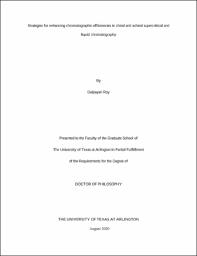
ATTENTION: The works hosted here are being migrated to a new repository that will consolidate resources, improve discoverability, and better show UTA's research impact on the global community. We will update authors as the migration progresses. Please see MavMatrix for more information.
Show simple item record
| dc.contributor.advisor | Armstrong, Daniel W. | |
| dc.creator | Roy, Daipayan | |
| dc.date.accessioned | 2020-09-10T17:44:30Z | |
| dc.date.available | 2020-09-10T17:44:30Z | |
| dc.date.created | 2020-08 | |
| dc.date.issued | 2020-09-01 | |
| dc.date.submitted | August 2020 | |
| dc.identifier.uri | http://hdl.handle.net/10106/29421 | |
| dc.description.abstract | The fundamental aim of chromatography has been to achieve baseline separation between the components of a mixture in the shortest possible time. Recently there has been a shift in the chromatographic focus of enantiomeric separations, with an emphasis on increasing the efficiency of columns. Superficially porous particles (SPP) introduced about a decade ago lead to a surge in efficiency as compared to the traditionally used fully porous particles (FPP). Recently chiral selectors bonded to superficially porous particles have been commercialized.
This work reports new methods for enantioseparation using chiral selectors like macrocyclic glycopeptides, modified cyclodextrins and cyclofructans bonded to SPPs. Novel methodologies have been developed for 150 pharmaceutically relevant small molecules using both HPLC and SFC. Also, a newly developed macrocyclic glycopeptide stationary phase was used to separate enantiomers of nicotine related compounds. This work also focuses on the advantages of switching from FPPs to SPPs in SFC, by comparing van Deemter plots.
This work investigates the effect of water as an additive in supercritical fluid chromatography. Investigation reveals distinct behaviors of different stationary phase chemistries with the addition of water. Polar stationary phases showed up to a nine-fold gain in efficiency. This phenomenon was exploited to make SFC more environmentally sustainable. The modifier methanol, which is toxic to humans, was replaced by azeotropic ethanol which is nontoxic and is derived from a renewable source. The inherent water in this azeotrope produced increased efficiencies and decreased retention times and therefore resulted in lower consumption of organic modifier consumption, thereby making SFC ‘greener’. | |
| dc.format.mimetype | application/pdf | |
| dc.language.iso | en_US | |
| dc.subject | Chromatography | |
| dc.subject | Supercritical fluid chromatography | |
| dc.subject | Chiral separations | |
| dc.title | Strategies for enhancing chromatographic efficiencies in chiral and achiral supercritical and liquid chromatography | |
| dc.type | Thesis | |
| dc.degree.department | Chemistry and Biochemistry | |
| dc.degree.name | Doctor of Philosophy in Chemistry | |
| dc.date.updated | 2020-09-10T17:44:31Z | |
| thesis.degree.department | Chemistry and Biochemistry | |
| thesis.degree.grantor | The University of Texas at Arlington | |
| thesis.degree.level | Doctoral | |
| thesis.degree.name | Doctor of Philosophy in Chemistry | |
| dc.type.material | text | |
| dc.creator.orcid | 0000-0002-5924-2763 | |
Files in this item
- Name:
- ROY-DISSERTATION-2020.pdf
- Size:
- 10.16Mb
- Format:
- PDF
This item appears in the following Collection(s)
Show simple item record


